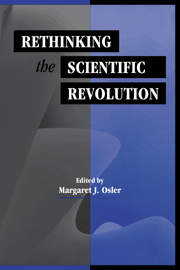Book contents
- Frontmatter
- Contents
- List of Contributors
- Preface
- Introduction
- Part I The Canon in Question
- Part II Canonical Disciplines Re-Formed
- 4 The Role of Religion in the Lutheran Response to Copernicus
- 5 Catholic Natural Philosophy: Alchemy and the Revivification of Sir Kenelm Digby
- 6 Vital Spirits: Redemption, Artisanship, and the New Philosophy in Early Modern Europe
- 7 “The Terriblest Eclipse That Hath Been Seen in Our Days”: Black Monday and the Debate on Astrology during the Interregnum
- 8 Arguing about Nothing: Henry More and Robert Boyle on the Theological Implications of the Void
- Part III Canonical Figures Reconsidered
- Part IV The Canon Constructed
- Index
6 - Vital Spirits: Redemption, Artisanship, and the New Philosophy in Early Modern Europe
Published online by Cambridge University Press: 25 October 2009
- Frontmatter
- Contents
- List of Contributors
- Preface
- Introduction
- Part I The Canon in Question
- Part II Canonical Disciplines Re-Formed
- 4 The Role of Religion in the Lutheran Response to Copernicus
- 5 Catholic Natural Philosophy: Alchemy and the Revivification of Sir Kenelm Digby
- 6 Vital Spirits: Redemption, Artisanship, and the New Philosophy in Early Modern Europe
- 7 “The Terriblest Eclipse That Hath Been Seen in Our Days”: Black Monday and the Debate on Astrology during the Interregnum
- 8 Arguing about Nothing: Henry More and Robert Boyle on the Theological Implications of the Void
- Part III Canonical Figures Reconsidered
- Part IV The Canon Constructed
- Index
Summary
In his youth the German chemist Johann Rudolph Glauber (1603/4–70) passed through Basel, where he met a philosophically minded man who showed him his own dead child preserved in the water from a nearby spring. Although this child had died some time before, its corpse remained untouched by putrefaction. Glauber never saw the source in Switzerland from which this water came, but he happened upon a similar spring in Vienna-Neustadt. The water in this spring transmuted everything placed in it into stone, preventing all things from rotting. Moreover it cured Glauber of a long and difficult fever. Glauber stayed the whole winter observing this spring and found that it prevented the swamps from freezing, kept the grass green around its edge, and supported numerous turtles and other amphibious animals during the cold winter.
Later, after many years of reading and experimenting, Glauber claimed to have discovered the makeup of the salt that gave this spring it powers. He called it sal mirabile, for the wonders it could work, and claimed that he produced it from common salt and sulfuric acid. He first announced his discovery in 1658, publishing a book about the nature of salts in general. In it he praised the manifold virtues of salt: it was the nutriment of all things, a symbol of eternity, the crucial ingredient in alchemical transmutation and in aurum potabile (potable gold), the cause of spontaneous generation, and the principle of all life. All salts, including common cooking salt, partook in the wondrous qualities of the elemental salt, but the sal mirabile was truly miraculous.
- Type
- Chapter
- Information
- Rethinking the Scientific Revolution , pp. 119 - 136Publisher: Cambridge University PressPrint publication year: 2000
- 9
- Cited by

